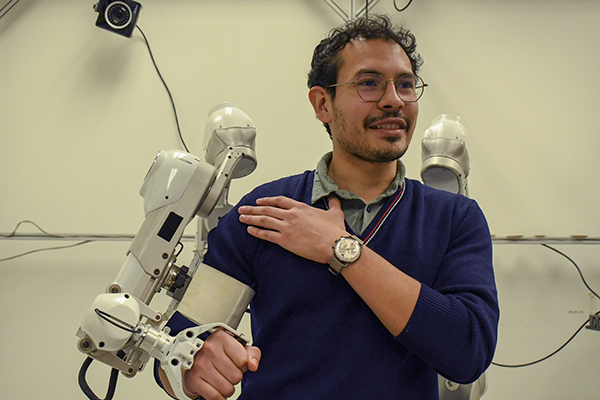A UT laboratory is testing a robotic exoskeleton that will be used to assist people who are recovering from a stroke.
ReNeu Robotics Lab in the Mechanical Engineering Department began creating the exoskeleton named Harmony in 2011. ReNeu, named from a combination of the words rehabilitation and neuromuscular, specializes in using robotics to “improve the quality of life and rehabilitation” for people living with a disability, according to the lab’s website.
According to the Centers for Disease Control and Prevention, stroke can result in long-term, severe disability and reduced mobility in more than half of survivors ages 65 and older.
Harmony is structured as a chair with two metal arms attached to shoulder joints that allow a user to move their arms in any direction, said Ana Oliveira, a ReNeu Lab engineer and mechanical engineering Ph.D. student.
“The idea is that the patient can wear the robot while performing therapeutic tasks,” Oliveira said. “The robot provides some assistance not only to help the patient to achieve the goal of the task, but achieve it in an anatomically correct way.”
Kaci Madden, a mechanical engineering Ph.D. student in the ReNeu Lab, wore the exoskeleton to test its gravity compensation mode. This mode allows for the patient to experience weightlessness while moving their arms.
“It was actually pretty gentle,” Madden said. “It didn’t feel unnatural at all. It’s like a gentle push in the right direction rather than a jerk.”
Job Ramirez, lab manager and research engineer, began helping to develop Harmony in 2017 when he was an undergraduate student.
Ramirez said one of the challenges of working with robots is that there are multiple ways of solving the same problems.
“Robotic arms have been designed for a couple of decades now, so it’s a matter of fitting towards our constraints,” Ramirez said. “The solutions are out there. What’s not out there is how to put together the solution to solve our problem.”
Another challenge ReNeu faces is fitting Harmony to a wide range of heights and shoulder widths, Oliveira said.
“The aesthetic choice is also part of it,” Oliveira said. “You don’t want patients that are going to use the device to be intimidated by it.”
Oliveira said working on Harmony is an experience for life.
“I’m very grateful for having this opportunity to be here and to be in contact with people that actually might benefit from this technology,” Oliveira said.





















